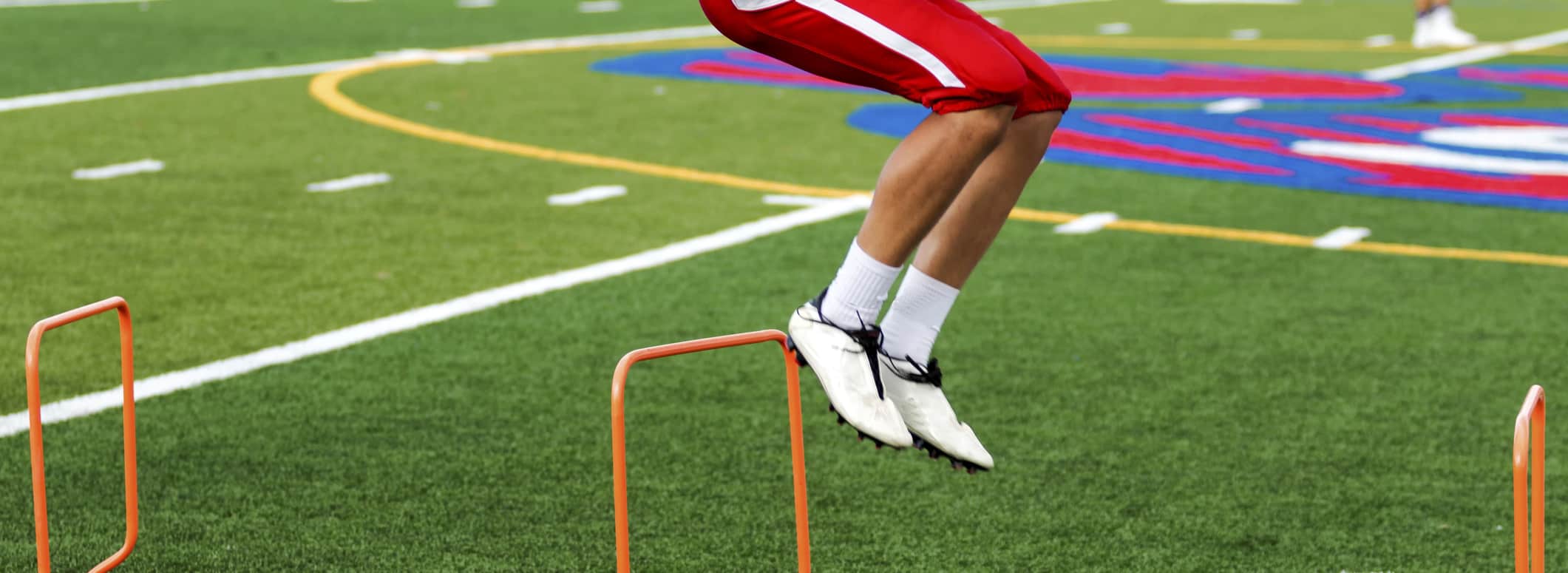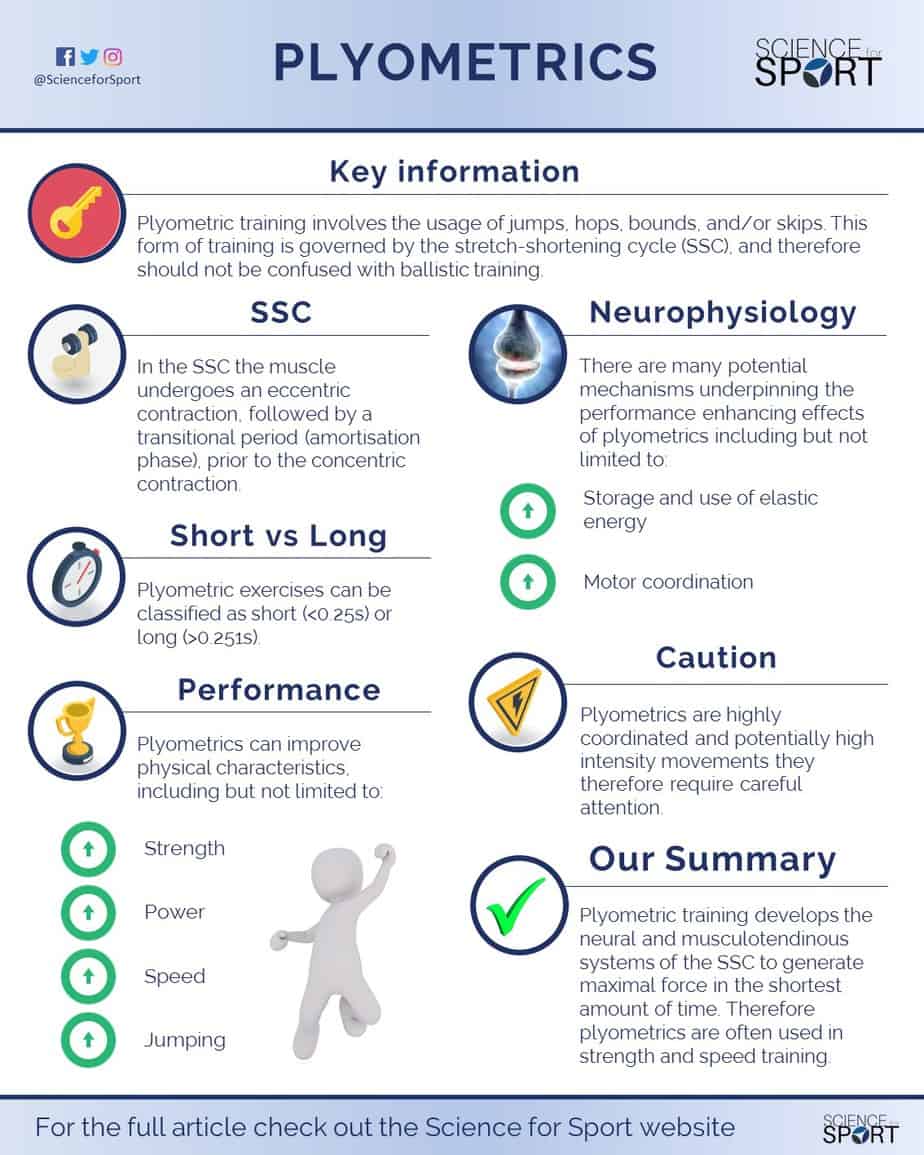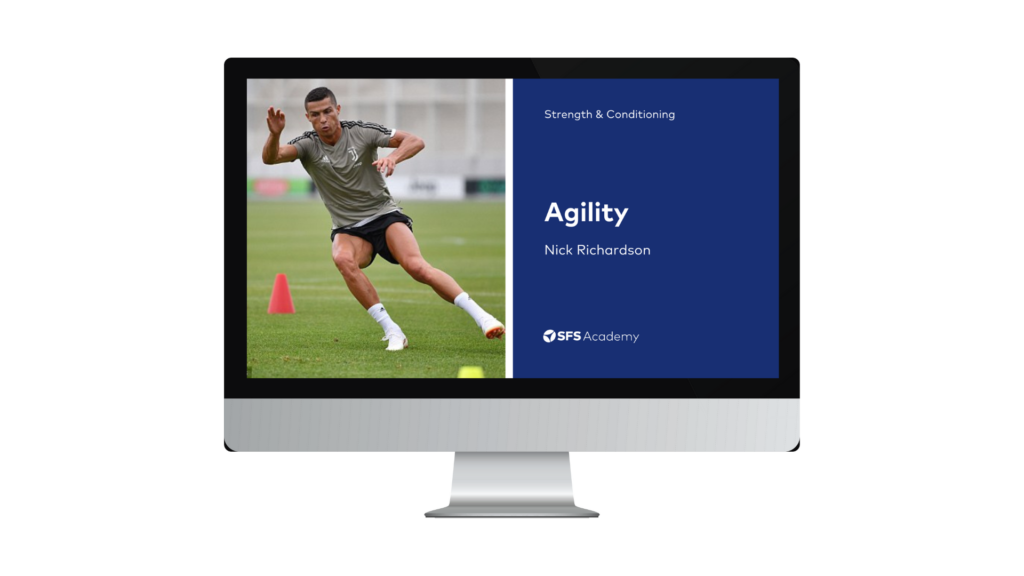Contents of Article
- Summary
- What is plyometric training?
- Why is plyometric training important for sport?
- How does plyometric training improve performance?
- Are there any issues with plyometric training?
- Conclusion
- References
- About the Author
Summary
Plyometric training involves the usage of jumps, hops, bounds, and/or skips and should not be confused with ballistic training. This form of training is governed by the stretch-shortening cycle, otherwise known as the reversible action of muscles. Plyometric activities can be separated into two categories depending upon the duration of the ground contact time: 1) fast plyometric movements (≤ 250 milliseconds (ms)); and 2) slow plyometric activities (≥ 251 ms).
This training modality appears to be very effective for improving athleticism in both youth and adult populations. Moreover, both land- and aquatic-based plyometric training appears to be a potent stimulus for improving athletic qualities. As plyometric activities are highly coordinated and skillful movements, they should be coached with full care and attention by qualified personnel.
Lastly, though training volume is relatively easy to measure, training intensity is far more complex due to the individual variability of each athlete.

What is plyometric training?
Plyometric training, otherwise referred to as ‘plyometrics’ or ‘shock training’, is a training modality that often requires athletes to jump, hop, bound and/or skip. Plyometrics should not be confused with ‘ballistic’ training, which is ultimately another word for ‘trajectory’ training. Ballistic training involves the trajectory of objects and implements (e.g. barbells and medicine balls), whereas plyometric training uses the previously mentioned movements.
Having said this, it is important to understand in some circumstances there is a degree of crossover, where some movements are considered both ballistic and plyometric. Ultimately the differing factor between the two is that plyometric training typically involves rapid reactive contacts with a surface (e.g. foot contacts during sprinting), whilst ballistic training involves the trajectory of objects/implements.
Plyometric training takes advantage of a rapid cyclical muscle action known as the ‘stretch-shortening cycle (SSC)‘, whereby the muscle undergoes an eccentric contraction, followed by a transitional period prior to the concentric contraction (1) (Figure 1). Figure 1 demonstrates an athlete’s ankle moving through the SSC sequence (eccentric, to amortization, to concentric) during a jump. Therefore, this muscle action (i.e. SSC) is often referred to as reversible action of muscles (2) and is existent in all forms of human motion whenever a body segment changes direction.

Duration of the ground contact time
During walking, running and jumping our feet continuously strike the ground and then leave it again in a reciprocal fashion – meaning when one foot leaves the ground, the other is quick to contact it. The time period in which the foot is in contact with the ground is known as the ‘ground contact time’ (GCT). During sprinting, for example, the foot GCT can be anywhere between 80-90 ms (3).
Plyometric movements which are synonymous with the SSC, are classified as either ‘slow’ or ‘fast’ plyometric activities (2).
- Slow plyometric exercise = GCT ≥ 251 ms (0.251 seconds)
- Fast plyometric exercise = GCT ≤ 250 ms (0.25 seconds)
Table 1 provides some clear examples of the GCTs during common movements and their plyometric classifications.
| Exercise | Ground Contact Time (ms) | SSC Classification |
| Race Walking (4) | 270-300 | Slow |
| Sprinting (5) | 80-90 | Fast |
| Countermovement Jump (CMJ) (6) | 500 | Slow |
| Depth Jump (20-60cm) (7,8) | 130-300 | Fast/Slow |
| Long Jump (9) | 140-170 | Fast |
| Multiple Hurdle Jumps (10) | 150 | Fast |
| Basketball Lay-Up Shot (11) | 218 | Fast |
Why is plyometric training important for sport?
As the SSC exists in all forms of human motion from changing direction in rugby to jumping in basketball, and even sprinting in the 100m, it becomes obvious that all of these movements can be deemed as plyometric activities. As all of these movements are classified as plyometric movements/activities/exercises, its importance in sport suddenly becomes transparent.
With the growing interest in plyometric training, many researchers have attempted to identify the potency of this training modality for improving athletic performance. To date, plyometric training has been shown to improve the following physical qualities in both youth and adult populations:
- Strength (12-23)
- Speed (1, 12-16, 18, 20, 21, 25-31)
- Power (16, 18, 28, 31, 32)
- Change of Direction Speed (14, 21, 27, 30, 33-35)
- Balance (12, 15, 16, 23)
- Jumping (14-19, 21, 24, 25, 27-39)
- Throwing (18, 32)
- Kicking (34, 26, 21, 39)
- Bone density (40, 31)
Furthermore, even aquatic plyometrics have been shown to improve:
- Speed (12)
- Change of Direction Speed (33)
- Balance (12)
- Jumping (33)
How does plyometric training improve performance?
Though seemingly simple, this is, in fact, a difficult, and very exhaustive, question to answer. As plyometric training is governed by the SSC, the question “how does plyometric training improve performance” is perhaps better referred to as “how do changes to the SSC improve performance?”
Many neurophysiological mechanisms have been considered to underpin and explain the impact of plyometric training on the SSC. Most of which include:
- Improved storage and utilisation of elastic strain energy (41-43)
- Increased active muscle working range (44, 45)
- Enhanced involuntary nervous reflexes (46, 47)
- Enhanced length-tension characteristics (48)
- Increased muscular pre-activity (49, 50),
- Enhanced motor coordination (44, 45)
Whilst there is still no consensus as to which of these neurophysiological adaptations is primarily responsible for the enhancement of the SSC, research is beginning to highlight the significance of the following mechanisms:
- Improved storage and utilisation of elastic strain energy (2, 51)
- Increase in active state due to an increase in the active working range (2, 51)
Improving these qualities will likely lead to an increase in leg stiffness during contact with the ground, and also force production during the concentric contraction. Increases in both leg stiffness and force production will likely lead to improvements in athletic performance.
If you wish to understand these mechanisms in greater detail, we recommend you read our article on the Stretch-Shortening Cycle (SSC).
Are there any issues with plyometric training?
Though plyometric training is a very potent training modality for improving athletic performance, there are several important issues practitioners must fully understand and take into consideration before they attempt to deliver any form of training prescription.
Plyometrics are highly coordinated and skillful movements
Plyometric activities require athletes to produce high levels of force during very fast movements. They also demand the athletes to produce this force during very short timeframes. Perhaps the best example of this is sprinting. Maximal speed sprinting demands the athlete moves their body and limbs at the very pinnacle of their ability – making it an extremely fast movement.
Athletes have also been shown to produce ground reaction forces during each foot contact of 3-4 times body weight (52, 53). Not only that, but they must apply these huge forces in a GCT of just 80-90 ms (3). So during sprinting, athletes are required to move as quickly as possible, produce forces of over 3-4 times bodyweight, and do so in just 80-90 ms.
As a result, plyometrics are not typically seen as just exercises or drills, but more as complex ‘movement skills’ due to their high complexity. Understanding this is vital and highlights how highly-coordinated these movements are, and why they require a large amount of attention and coaching if optimal, yet safe, performance gains are to be made.
The intensity of plyometrics is difficult to measure
Arguably, volume of plyometric training is relatively easy to measure and prescribe and is typically done so by counting the number of ground contacts per session, otherwise referred to as simply ‘contacts’. However, measuring and prescribing plyometric intensity is far more complex. To accurately measure plyometric intensity, the following components must be taken into consideration (2):
- Speed of movement
- Amplitude of movement
- Points of contact (i.e. unilateral or bilateral)
- Body mass
- Technical competencies
- Strain yielding competencies
To provide just one example, let’s take a quick look at body mass. If two athletes perform a drop-jump from a 30cm box, but athlete A is 60kg and athlete B is 80kg, then athlete B has to absorb and re-apply more force than athlete A simply because of their weight.
This simple example demonstrates how the intensity of this plyometric activity is different for each of these athletes. Practitioners must ensure they take this information into consideration when planning and prescribing any form of plyometric training.
Conclusion
Plyometric training is primarily used by strength and conditioning coaches to enhance human neuromuscular function and improve the performances of both explosive- and endurance-based athletes (54). It is commonly agreed that plyometric training develops the neural and musculotendinous systems of the SSC to generate maximal force in the shortest amount of time.
Given this, plyometrics are often used as a method of training to bridge the division between strength and speed (54). Even despite rigorous scientific investigation, plyometric training continues to prove itself as a potent training method for enhancing athletic performance.
- Lloyd, R.S., Oliver, J.L., Hughes, M.G., and Williams, C.A. (2012). The effects of 4-weeks of plyometric training on reactive strength index and leg stiffness in male youths. Journal of Strength and Conditioning Research, 26(10), pp.2812–2819. [PubMed]
- Turner, A.N. & Jeffreys, I. (2010). The stretch-shortening cycle: proposed mechanisms and methods for enhancement. Journal of Strength and Conditioning Research, 17, 60-67. [Link]
- Taylor, M. J. D., & Beneke, R. (2012). Spring Mass Characteristics of the Fastest Men on Earth.International journal of sports medicine, 33(8), 667. [PubMed]
- Padulo, J, Annino, G, D’Ottavio, S, Vernillo, G, Smith, L, Migliaccio, GM, and Tihanyi, J. Footstep analysis at different slopes and speeds in elite race walking. J Strength Cond Res 27(1): 125–129, 2013 [PubMed]
- Taylor, M. J. D., & Beneke, R. (2012). Spring Mass Characteristics of the Fastest Men on Earth.International journal of sports medicine, 33(8), 667.[PubMed]
- Laffaye, G., & Wagner, P. (2013). Eccentric rate of force development determines jumping performance. Computer Methods in Biomechanics and Biomedical Engineering, 16(1), pp.82–83. [Link]
- Ball, NB, Stock, CG, and Scurr, JC. Bilateral contact ground reaction forces and contact times during plyometric drop jumping. J Strength Cond Res 24(10): 2762–2769, 2010. [PubMed]
- Walsh, M, Arampatzis, A, Schade, F, and Bruggemann, G. The effect of drop jump starting height and contact time on power, work performed and moment of force. J Strength Cond Res 18: 561–566, 2004. [PubMed]
- Stefanyshyn, D. & Nigg, B. (1998) Contribution of the lower extremity joints to mechanical energy in running vertical jumps and running long jumps. Journal of Sport Sciences, 16, 177-186. [PubMed]
- Flanagan EP and Comyns TM. The use of contact time and the reactive strength index to optimise fast stretch-shortening cycle training. Strength Cond J 30: 33– 38, 2008. [Link]
- Miura, K, Yamamoto, M, Tamaki, H, and Zushi, K. Determinants of the abilities to jump higher and shorten the contact time in a running 1-legged vertical jump in basketball. J Strength Cond Res 24(1): 201–206, 2010. [PubMed]
- Arazi H, Asadi A. The effect of aquatic and land plyometric training on strength, sprint, and balance in young basketball players. J. Hum. Sport Exerc. Vol. 6, No. 1, pp. 101-111, 2011. [Link]
- Behringer, M., Neuerberg, S., Matthews, M. & Mester, J. (2013). Effects of Two Different Resistance- Training Programs on Mean Tennis-Serve Velocity in Adolescents. Paediatric Exercise Science, 25, 370-384. [Link]
- Chaouachi, A., Hammami, R., Kaabi, S., Chamari, K., Drinkwater, E.J. & Behm, D.G. (2014). The combination of plyometric and balance training improves sprint and shuttle run performances more often than plyometric-only training with children. Journal of Strength and Conditioning Research, 28(2), 401–412. [PubMed]
- Chaouachi, A., Hammami, R., Kaabi, S., Chamari, K., Drinkwater, E.J. & Behm, D.G. (2014). Olympic weightlifting and plyometric training with children provides similar or greater performance improvements than traditional resistance training. Journal of Strength and Conditioning Research, 28(6), 1483–1496. [Link]
- Campillo, RR, Andrade, DC, and Izquierdo, M. Effects of plyometric training volume and training surface on explosive strength. J Strength Cond Res 27(10): 2714–2722, 2013. [PubMed]
- Fouré A, Nordez A, Guette M, Cornu C. Effects of plyometric training on passive stiffness of gastrocnemii and the musculo-articular complex of the ankle joint. Scand J Med Sci Sports. 2009 Dec;19(6):811-8. [PubMed]
- Chelly, M.S., Hermassi, S., Aouadi, R., and Shephard, R.J. (2014). Effects of 8-week in-season plyometric training on upper and lower limb performance of elite adolescent handball players. Journal of Strength and Conditioning Research, 28(5), 1401–1410. [PubMed]
- Martel, G.F., Harmer, M.l., Logan, J.M. & Parker, C.B. (2005). Aquatic Plyometric Training Increases Vertical Jump in Female Volleyball Players. Medicine and Science in Sports and Exercise, 37(10), 1814–1819. [PubMed]
- Milenković D. Explosiveness in training process of football players. Sport Science 6 (2013) 2: 72‐ [Link]
- Michailidis, Y, Fatouros, IG, Primpa, E, Michailidis, C, Avloniti, A, Chatzinikolaou, A, Barbero-A´ lvarez, JC, Tsoukas, D, Douroudos, II, Draganidis, D, Leontsini, D, Margonis, K, Berberidou, F, and Kambas, A. Plyometrics’ trainability in preadolescent soccer athletes. J Strength Cond Res 27(1): 38–49, 2013 [PubMed]
- Pfile KR, Hart JM, Herman DC, Hertel J, Kerrigan DC, Ingersoll CD. Different exercise training interventions and drop-landing biomechanics in high school female athletes. J Athl Train. 2013 Jul-Aug;48(4):450-62. [PubMed]
- WITZKE, K. A. and C. M. SNOW. Effects of plyometric jump training on bone mass in adolescent girls. Med. Sci. Sports Exerc., Vol. 32, No. 6, pp. 1051–1057, 2000. [Link]
- Bishop, DC, Smith, RJ, Smith, MF, and Rigby, HE. Effect of plyometric training on swimming block start performance in adolescents. J Strength Cond Res 23(7): 2137–2143, 2009. [PubMed]
- Kotzamanidis, C. Effect of plyometric training on running performance and vertical jumping in prepubertal boys. J. Strength Cond. Res. 20(2):441–445. 2006. [PubMed]
- Marques MC, Pereira A, Reis IG, van den Tillaar R. Does an in-Season 6-Week Combined Sprint and Jump Training Program Improve Strength-Speed Abilities and Kicking Performance in Young Soccer Players? Journal of Human Kinetics volume 39/2013, 157-166. [PubMed]
- Meylan C, Malatesta D. Effects of in-season plyometric training within soccer practice on explosive actions of young players. J Strength Cond Res. 2009 Dec;23(9):2605-13. [PubMed]
- Ozbar, N., Ates, S. & Agopyan, A. (2014). The effect of 8-week plyometric training on leg power, jump and sprint performance in female soccer players. Journal of Strength and Conditioning Research, 28(10), 2888– 2894. [PubMed]
- Potdevin, FJ, Alberty, ME, Chevutschi, A, Pelayo, P, and Sidney, MC. Effects of a 6-week plyometric training program on performances in pubescent swimmers. J Strength Cond Res 25(1): 80–86, 2011. [PubMed]
- Sohnlein, Q., Muller, E. & Stoggl, T.L. (2014). The effect of 16-week plyometric training on explosive actions in early to mid-puberty elite soccer players. Journal of Strength and Conditioning Research, 28(8), 2105–2114. [PubMed]
- Zribi A, Zouch M, Chaari H, Bouajina E, Ben Nasr H, Zaouali M, Tabka Z. Short-term lower-body plyometric training improves whole body BMC, bone metabolic markers, and physical fitness in early pubertal male basketball players. Pediatr Exerc Sci. 2014 Feb;26(1):22-32. [PubMed]
- Santos, EJAM and Janeira, MAAS. The effects of plyometric training followed by detraining and reduced training periods on explosive strength in adolescent male basketball players. J Strength Cond Res 25(2): 441–452, 2011. [Link]
- Arazi H, Coetzee B, Asadi A. Comparative effect of land- and Aquatic-based plyometric training on jumping ability and Agility of young basketball players. South African Journal for Research in Sport, Physical Education and Recreation, 2012, 34(2): 1-14. [Link]
- Ramırez-Campillo, R, Meylan, C,A´ lvarez, C, Henrı´quez-Olguı´n, C, Martı´nez, C, Can˜as-Jamett, R, Andrade, DC, and Izquierdo, M. Effects of in-season low-volume high-intensity plyometric training on explosive actions and endurance of young soccer players. J Strength Cond Res 28(5): 1335–1342, 2014. [PubMed]
- Mulcahy, R.L., and Crowther, R.G. (2013) The effects of an 8 week supplemented plyometric exercise training program on leg power, agility and speed in adolescent netball players. Journal of Australian Strength and Conditioning, 21 (3). pp. 28-33. [Link]
- Alptekin A, Kılıç O, Maviş M. The effect of an 8-week plyometric training program on sprint and jumping performance. Serbian Journal of Sports Sciences;2013, Vol. 7 Issue 2, p45. [Link]
- Stojanovic N, Jovanović N, Stojanović T. The effects of plyometric training on the development of the jumping agility in volleyball players. Facta Universitatis: Series Physical Education & Sport;2012, Vol. 10 Issue 1, p59. [Link]
- Siti MI, et al. Enhancing jump ground reaction forces in children through jump training. South African Journal for Research in Sport, Physical Education ;2014, Vol. 36 Issue 1, p199. [Link]
- Rubley, M.D., Haase, A.C., Holcomb, W.R., Girouard, T.J. & Tandy, R.D. (2011). The effect of plyometric training on power and kicking distance in female adolescent soccer players. Journal of Strength and Conditioning Research, 25(1), 129–134. [PubMed]
- Bass, S.L. (2000). The prepubertal years – a unique opportune stage of growth when the skeleton is most responsive to exercise. Sports Medicine, 30, 73-78. [PubMed]
- Bojsen-Moller J, Magnnusson SP, Rasmussen LR, Kjaer M, and Aagaard P. Muscle performance during maximal isometric and dynamic contractions is influenced by the stiffness of tendinous structures. J Appl Physiol 99: 986–994, 2005. [PubMed]
- Finni T, Ikegaw S, and Komi PV. Concentric force enhancement during human movement. Acta Physiol Scand 173: 369–377, 2001. [PubMed]
- Kubo K, Kawakami Y, and Fukunaga T. Influence of elastic properties of tendon structures on jump performance in humans. J Appl Physiol 87: 2090–2096, 1999. [PubMed]
- Bobbert, M.F., and Casius, L.J. (2005). Is the countermovement on jump height due to active state development? Medicine and Science in Sport and exercise, 37(5), pp.440–446. [PubMed]
- Bobbert, M.F., Gerritsen, K.G.M., Litjens, M.C.A., and Van Soest, A.J. (1996). Why is countermovement jump height greater than squat jump height? Medicine and Science in Sports and Exercise, 28(23), pp.1402–1412. [PubMed]
- Bosco C, Montanari G, Ribacchi R, Giovenali P, Latteri F, Iachelli G, Faina M, Coli R, DalMonte A, Las RosaM,CortelliG, and Saibene F. Relationship between the efficiency of muscular work during jumping and the energetic of running. Eur J Appl Physiol 56: 138–143, 1987. [PubMed]
- Bosco C, Komi PV, and Ito A. Pre-stretch potentiation of human skeletal muscle during ballistiv movement. Acta Physiol Scand 111: 135–140, 1981. [PubMed]
- Finni T, Ikegawa S, Lepola V, and Komi P. In vivo behaviour of vastus lateralis muscle during dynamic performances. Eur J Sport Sci 1: 1–13, 2001. [Link]
- McBride JM,McCaulleyGO, and Cormie P. Influence of preactivity and eccentric muscle activity on concentric performance during vertical jumping. J Strength Cond Res 23: 750–757, 2008. [PubMed]
- Kyrolainen H, Komi PV, and Kim DH. Effects of power training on neuromuscular performance and mechanical efficiency. Scand J Med Sci Sports 1: 78–87, 1991. [Link]
- Wilson, JM and Flanagan, EP. The role of elastic energy in activities with high force and power requirements: A brief review. J Strength Cond Res 22(5): 1705–1715, 2008. [PubMed]
- Weyand, Peter G., Deborah B. Sternlight, Matthew J. Bellizzi, and Seth Wright. Faster top running speeds are achieved with greater ground forces not more rapid leg movements. J Appl Physiol 89: 1991–1999, 2000. [PubMed]
- BEZODIS, I. N., D. G. KERWIN, and A. I. T. SALO. Lower-Limb Mechanics during the Support Phase of Maximum-Velocity Sprint Running. Med. Sci. Sports Exerc., Vol. 40, No. 4, pp. 707–715, 2008. [PubMed]
- Markovic G. & Mikulic, P. (2010). Neuro-musculoskeletal and performance adaptations to lower extremity plyometric training. Sports Medicine, 40(10), 859-895. [PubMed]





